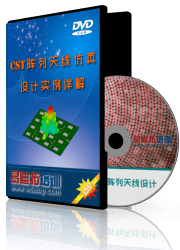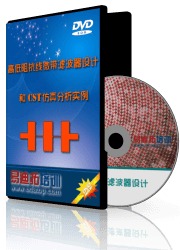- 易迪拓培训,专注于微波、射频、天线设计工程师的培养
CST2013: Thermal Loss Distribution Overview
Thermal loss distributions are computed from electromagnetic fields or particle losses and link the thermal solver to other CST STUDIO SUITE solvers. In principal a thermal computation can be don within the electromagnetic- / particle-project or in a separate project.
The thermal loss distribution is always mapped to the grid of thermal solver and is added to the 2D / 3D Results tree folder during the simulation process.
Single project coupling
If both the electromagnetic field solver and the thermal solver are based on a hexahedral grid, it is possible to carry out both computations within a single project. This type of coupling allows to do parameter sweep and optimizations of a coupled thermal simulation.
The workflow to link in the thermal solver is as follows:
Define electromagnetic field monitors (for some solvers not necessary).
Calculate electromagnetic fields or particle distributions.
Import losses into thermal solver (Solve
 Thermal Loss Distribution).
Thermal Loss Distribution).Run the thermal simulation (Solve
 Thermal Stationary Solver / Thermal Transient Solver).
Thermal Stationary Solver / Thermal Transient Solver).
The thermal loss distribution is calculated automatically right before the thermal solver starts.
Two projects coupling
If the meshes of the primary solver an the thermal solver should be different, two different projects need to be connected. The workflow is as follows:
Define electromagnetic field monitors (for some solvers not necessary).
Calculate electromagnetic fields or particle distributions.
Calculate thermal loss distributions (Results
 Calculate Thermal Losses).
Calculate Thermal Losses).Switch to the thermal project.
Import losses into thermal solver (Solve
 Thermal Loss Distribution).
Thermal Loss Distribution).Run the thermal simulation (Solve
 Thermal Stationary Solver / Thermal Transient Solver).
Thermal Stationary Solver / Thermal Transient Solver).
This workflow requires to compute the thermal loss distributions manually or via postprocessing template after the electromagnetic- or particle-simulation has been finished.
Creating simulation tasks
Another possibility to perform parameter sweep and optimizations of a coupled thermal simulation is to create multiple simulation project simulation tasks in DESIGN STUDIO and couple them in the way described in the previous section.
Switch to the DESIGN STUDIO tab of the project.
Create the needed sequence of simulation projects (Simulation
 New Simulation Project...).
New Simulation Project...).Couple the simulation projects as it has been described in the previous section.
For more information please refer to CST DESIGN STUDIO help.
Field Monitors
Some electromagnetic solvers require to define field monitors in order to store the electromagnetic fields for a subsequent thermal loss calculation. The following table gives an overview which monitors deliver usable results:
Field monitor | Description |
Electric field | Electric fields are used together with the material properties to compute volumetric thermal loss distributions. Only available for hexahedral-based solvers. |
Current density field | Current density fields are used together with the material properties to compute volumetric thermal loss distributions. Only available for hexahedral-based solvers. |
Magnetic field | Magnetic fields can be used to compute surface based thermal losses caused by surface impedance models or volumetric thermal losses caused inside dispersive materials. Only available for hexahedral-based solvers. |
Power loss density | Power loss densities only need to be mapped to the grid which is used by the thermal solver. This is the only available type of monitor for tetrahedral based solvers. |
Particle losses | Particle losses are not recorded by usage of a monitor definition, but with a special solver option in the Tracking- or PIC-solver settings. |
Note: Power loss densities are created by an interpolation from field results. Since the discrete representation of these losses is not located where the thermal solver needs it, a second interpolation is necessary. To avoid inaccuracies it is always advisable to use electric or current density monitors for the thermal loss distribution calculation instead of power loss densities if possible. Tetrahedral solvers only support the linkage with power loss densities to the thermal solver.
Loss Interpolation
Transferring losses from EM- or Particle solvers to thermal solvers involves at least one interpolation step. In addition the loss distribution is a secondary result in any EM- / Particle-solver which means that an electric field, a magnetic field or a particle movement is evaluated to create the loss distribution. Summing up the following sequence of steps is performed to create a loss distribution which can be used by a thermal solver:
Compute EM fields
Evaluate loss distribution
Extract losses for the sub-volume of the thermal simulation (incl. boundary settings)
Interpolate losses to the thermal solvers mesh.
Especially during the steps 3 and 4 the total amount of loss power can be reduced compared to the value after step 2 was finished. There a various reasons why this happens and often this is intended by the user. The following factors can reduce the total amount of loss power:
reduced size of the thermal simulation domain,
excluding boundaries from the loss computation,
defining a threshold value for the loss mapping (to avoid overheating in regions of low thermal conductivity),
interpolation errors.
It is very important for an accurate thermal simulation that the total amount of losses is transferred to the thermal solver correctly. Please check these values in the "Heat Flow Values" after the simulation was finished.
See also:
Thermal Stationary Solver Overview, Thermal Transient Solver Overview, Calculate Thermal Losses, Thermal Loss Distribution, Field Monitor
CST微波工作室培训课程套装,专家讲解,视频教学,帮助您快速学习掌握CST设计应用
上一篇:CST2013: Special Mesh Properties - Thermal
下一篇:CST2013: Frequency Domain Solver Overview - Resonant: Fast S-Parameter
CST中文视频培训教程 | More...
 最全面、最专业的CST微波工作室视频培训课程,可以帮助您从零开始,全面系统学习CST的设计应用【More..】
最全面、最专业的CST微波工作室视频培训课程,可以帮助您从零开始,全面系统学习CST的设计应用【More..】
频道总排行
- CST2013: Mesh Problem Handling
- CST2013: Field Source Overview
- CST2013: Discrete Port Overview
- CST2013: Sources and Boundary C
- CST2013: Multipin Port Overview
- CST2013: Farfield Overview
- CST2013: Waveguide Port
- CST2013: Frequency Domain Solver
- CST2013: Import ODB++ Files
- CST2013: Settings for Floquet B










